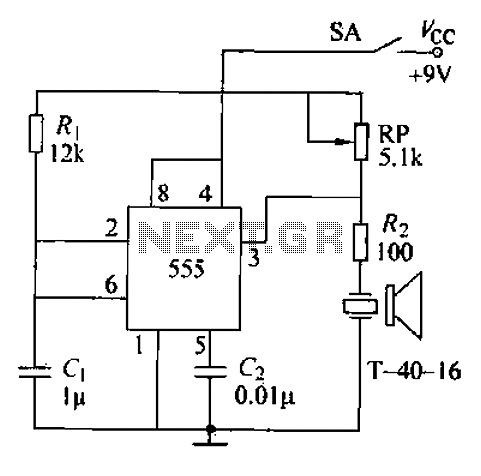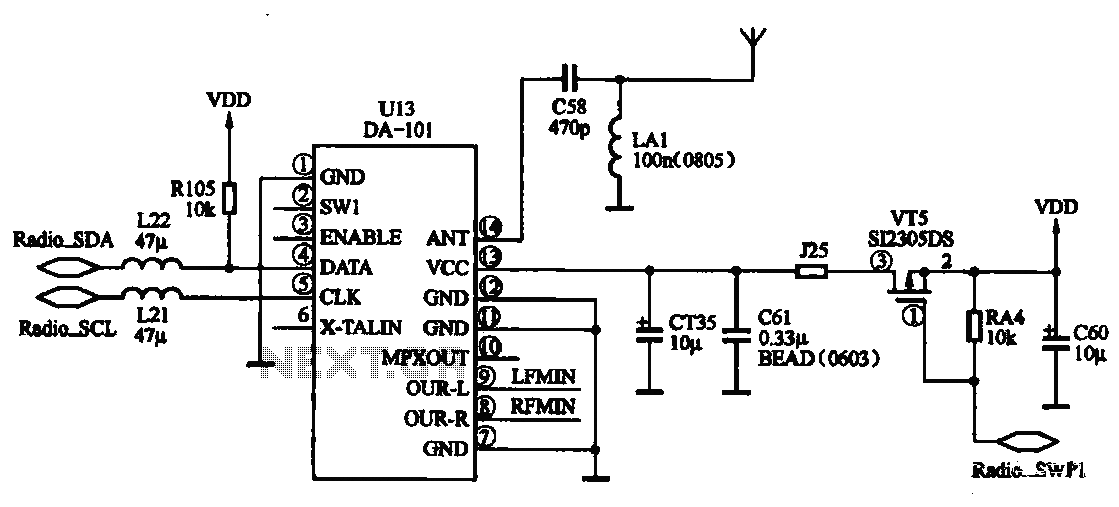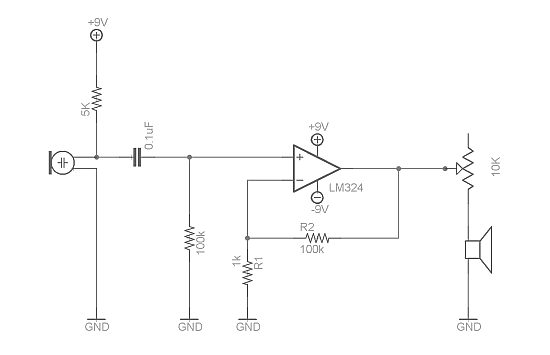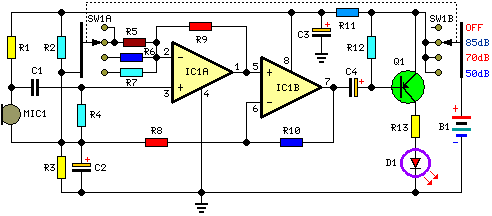
By the UCM-40-T and 74LS00 ultrasonic transmitter circuit consisting of NAND gate b

The circuit comprises an ultrasonic transmitter and a T-4 0-16 555 timer circuit. By adjusting the potentiometer RP, the frequency of the oscillation circuit can be modified. The circuit emits ultrasonic signals at a frequency of 40 kHz, with an effective range of 3 feet from the output of the 555 timer. The circuit operates at a voltage of 9V and draws a current of 40 to 45 mA, with a control distance exceeding 8 meters.
The ultrasonic transmitter circuit utilizes a T-4 0-16 timer configured in astable mode to generate a square wave output at a frequency of 40 kHz. The 555 timer is a versatile integrated circuit widely used in timer, delay, pulse generation, and oscillator applications. In this configuration, the frequency of oscillation can be adjusted by varying the resistance of the potentiometer RP, which is part of the timing network along with a capacitor connected to the discharge pin of the 555 timer.
The output from the timer drives a transducer that converts the electrical signal into ultrasonic sound waves. The operating voltage of the circuit is set at 9V, which is supplied by a suitable power source. The current consumption of the circuit ranges from 40 mA to 45 mA, ensuring efficient operation while providing sufficient power to the ultrasonic transducer.
The effective control distance of the emitted ultrasonic signals is more than 8 meters, allowing for applications such as distance measurement, obstacle detection, or even in pest repellent systems. The design of the circuit is compact and can be easily integrated into various electronic projects requiring ultrasonic sensing capabilities. The choice of components, including the 555 timer and the ultrasonic transducer, ensures reliability and performance in the intended applications. Circuit consists of an ultrasonic transmitter and T-4 0-16 555 circuit, adjust the potentiometer RP can change the oscillation circuit frequency. 40k 3 feet from the output 555 of azelaic z} oscillating pulse-driven T-4 0-16 work, so that emit ultrasonic signals of 40kHz. Circuit operating voltage of 9V. Operating current 40 ~ 45mA, control distance is more than 8m.
The ultrasonic transmitter circuit utilizes a T-4 0-16 timer configured in astable mode to generate a square wave output at a frequency of 40 kHz. The 555 timer is a versatile integrated circuit widely used in timer, delay, pulse generation, and oscillator applications. In this configuration, the frequency of oscillation can be adjusted by varying the resistance of the potentiometer RP, which is part of the timing network along with a capacitor connected to the discharge pin of the 555 timer.
The output from the timer drives a transducer that converts the electrical signal into ultrasonic sound waves. The operating voltage of the circuit is set at 9V, which is supplied by a suitable power source. The current consumption of the circuit ranges from 40 mA to 45 mA, ensuring efficient operation while providing sufficient power to the ultrasonic transducer.
The effective control distance of the emitted ultrasonic signals is more than 8 meters, allowing for applications such as distance measurement, obstacle detection, or even in pest repellent systems. The design of the circuit is compact and can be easily integrated into various electronic projects requiring ultrasonic sensing capabilities. The choice of components, including the 555 timer and the ultrasonic transducer, ensures reliability and performance in the intended applications. Circuit consists of an ultrasonic transmitter and T-4 0-16 555 circuit, adjust the potentiometer RP can change the oscillation circuit frequency. 40k 3 feet from the output 555 of azelaic z} oscillating pulse-driven T-4 0-16 work, so that emit ultrasonic signals of 40kHz. Circuit operating voltage of 9V. Operating current 40 ~ 45mA, control distance is more than 8m.





